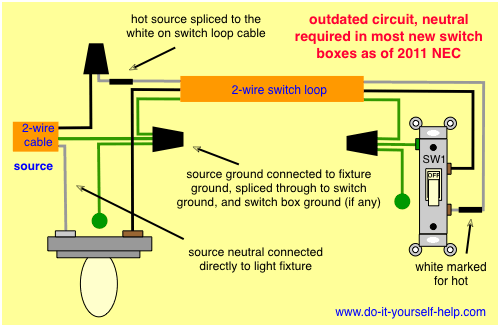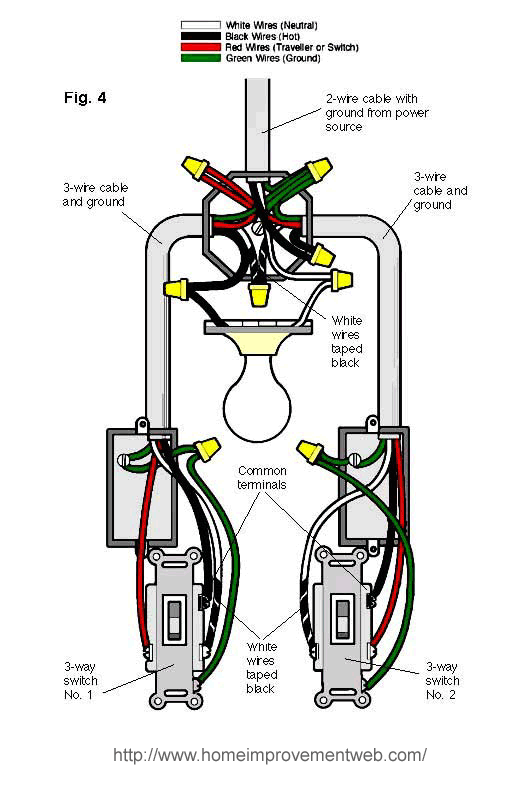- My Forums
- Tiger Rant
- LSU Recruiting
- SEC Rant
- Saints Talk
- Pelicans Talk
- More Sports Board
- Fantasy Sports
- Golf Board
- Soccer Board
- O-T Lounge
- Tech Board
- Home/Garden Board
- Outdoor Board
- Health/Fitness Board
- Movie/TV Board
- Book Board
- Music Board
- Political Talk
- Money Talk
- Fark Board
- Gaming Board
- Travel Board
- Food/Drink Board
- Ticket Exchange
- TD Help Board
Customize My Forums- View All Forums
- Show Left Links
- Topic Sort Options
- Trending Topics
- Recent Topics
- Active Topics
Started By
Message
Was it OK/common years ago to "rob" a neutral from a different circuit?
Posted on 7/7/21 at 1:15 pm
Posted on 7/7/21 at 1:15 pm
Changing a bathroom light/vent/heater in a house that's about 50 years old (not sure if the fixture is original, but it looks pretty old). Hot and neutral come to the switch, but the neutral is capped off there. Three conductors run up to the fixture, but they're all switched with no neutral. At the fixture, a neutral comes from a different junction box than the one going to the switch. I have not yet determined if they are on different circuits, but from the placement and wire runs that I can see I assume they are.
This fixture has been flaky since I bought the house a couple years ago. The vent seemed to struggle and I don't think the heater ever worked, but we never use anything but the light and I assumed the motors and heating element were just failing due to age. Now recently maybe once a month the light won't turn on unless you flick it a couple times. Change bulb and same thing. This forced me to replace the fixture. I would have done it sooner, but I was able to find only one model that fits the hole (15" and round), and it costs $200 and there are 3 of them in the house.
Anyway, my assumption about the wiring is that this is not the original fixture, and there used to be a light/vent unit with the neutral run correctly. Then later (but still long ago) the 3 function unit was added, and rather than pull new wire up the wall they decided to take the easy route and get a neutral from the junction box in the attic nearest the fixture.
Does that sound like something that would have happened? Whatever the case, should I pull new wire from the switch and tie in the neutral there? Or would it be alright to just move the neutral over to the same junction box that supplies the switch, all in the attic?
This fixture has been flaky since I bought the house a couple years ago. The vent seemed to struggle and I don't think the heater ever worked, but we never use anything but the light and I assumed the motors and heating element were just failing due to age. Now recently maybe once a month the light won't turn on unless you flick it a couple times. Change bulb and same thing. This forced me to replace the fixture. I would have done it sooner, but I was able to find only one model that fits the hole (15" and round), and it costs $200 and there are 3 of them in the house.
Anyway, my assumption about the wiring is that this is not the original fixture, and there used to be a light/vent unit with the neutral run correctly. Then later (but still long ago) the 3 function unit was added, and rather than pull new wire up the wall they decided to take the easy route and get a neutral from the junction box in the attic nearest the fixture.
Does that sound like something that would have happened? Whatever the case, should I pull new wire from the switch and tie in the neutral there? Or would it be alright to just move the neutral over to the same junction box that supplies the switch, all in the attic?
Posted on 7/7/21 at 1:18 pm to Korkstand
you wont run a neutral to a switch. The switch only switches the hot and you'd also run a ground to the switch. So 2 hots (1 hot hot[incoming to switch] and 1 switched hot [outgoing to fixture]) and 1 ground at the switch is common.
Posted on 7/7/21 at 1:50 pm to notsince98
quote:Yes I understand that a neutral doesn't get wired to the switch, but is it not common for the neutral to come to the switch box and tie to a neutral going to the fixture? Especially in the case of a dedicated circuit? I have since found that this circuit runs 40' straight to the breaker panel, which explains why a neutral was used from another circuit rather than a junction box on the same circuit.
you wont run a neutral to a switch
So I definitely need to pull new wire from the switch to the fixture, because I have 3 switches for 3 functions and only 3 wires run, and the current runs back out through another circuit. And given that the other circuit that the neutral is borrowed from powers the rest of the bathroom, that means I can't install a gfci in there until I get the light/vent/heater current back on its own circuit, right?
Posted on 7/7/21 at 2:51 pm to Korkstand
quote:
Yes I understand that a neutral doesn't get wired to the switch, but is it not common for the neutral to come to the switch box and tie to a neutral going to the fixture?
It depends how the circuit is run. That would be a waste of copper a lot of times. It is common to run the circuit homerun (Hot, neutral, ground) to a fixture and then only run the hot/ground to the switch. Even if the switch is closer to the source panel than the fixture, you might use a j-box above the ceiling to avoid needlessly routing the neutral down to the switch and wasting copper.
Posted on 7/7/21 at 3:16 pm to notsince98
Well, as it stands now I have 12/2 putting a hot and neutral straight from the breaker to the switch box. I also have 12/3 running from the switches to the fixture. The fixture gets neutral from a different circuit. Neutral is capped in the switch box.
My new fixture actually adds a 4th function (night light), so I need a 4th wire for that, so I will run 12/2 next to the existing 12/3 to give me 5 wires to the fixture. That will give me 4 switched hots and I can tie the neutral to the correct circuit. I can then eliminate the other 12/2 in the attic that will no longer serve a purpose, and I will no longer have current jumping across breakers.
My new fixture actually adds a 4th function (night light), so I need a 4th wire for that, so I will run 12/2 next to the existing 12/3 to give me 5 wires to the fixture. That will give me 4 switched hots and I can tie the neutral to the correct circuit. I can then eliminate the other 12/2 in the attic that will no longer serve a purpose, and I will no longer have current jumping across breakers.
This post was edited on 7/7/21 at 3:18 pm
Posted on 7/7/21 at 6:57 pm to Korkstand
Just to follow up, I went ahead and ran the new wire, installed the new fixture, and everything works great. I had to remove the old switch box and install a new one in order to pull the wire, but as I'm sure many of you know it wasn't very difficult.
I don't know exactly why back in the day someone used the neutral from a different circuit, but I feel better having found and fixed it.
Now I just have to do it 2 more times.
I don't know exactly why back in the day someone used the neutral from a different circuit, but I feel better having found and fixed it.
Now I just have to do it 2 more times.
Posted on 7/7/21 at 7:00 pm to Korkstand
quote:
Well, as it stands now I have 12/2 putting a hot and neutral straight from the breaker to the switch box. I also have 12/3 running from the switches to the fixture. The fixture gets neutral from a different circuit. Neutral is capped in the switch box.
I prefer running the neutral to the switch box as you alluded to and tying that back to the fixture. I also hate using a white as a switched circuit but understand that it is easier for purposes of wiring. If you drop another 12/3 you will have 4 switch conductors that are black or red. No question of which white is switched and which is the neutral for future reference.
If you use the white wire as a switched power leg, you are supposed to mark it as such to clearly identify it as being a conductor, typically done with black or red electrical tape wrapped around the individual conductor. A couple of example images below.


Posted on 7/7/21 at 7:44 pm to Korkstand
quote:
Was it OK/common years ago to "rob" a neutral from a different circuit?
Not really robbing a neutral, neutrals are common no matter what circuit they are on. As long as is doesn't leave an open/loaded neutral or return too much current on a given neutral it's fine as far as the circuit is concerned.
Posted on 7/7/21 at 8:44 pm to Clames
quote:They all connect to a common bar at the panel, but each circuit comes back on a single #12 neutral. As you suggested, this means I could overload that one neutral since two breakers were feeding it. Especially in this case where I have a 1500 watt heater on one circuit, and the neutral it was returning on was the rest of the bathroom which could have had a hair dryer or other high wattage appliances. I could have easily pushed 30+ amps down that one wire, right?
Not really robbing a neutral, neutrals are common no matter what circuit they are on. As long as is doesn't leave an open/loaded neutral or return too much current on a given neutral it's fine as far as the circuit is concerned.
Posted on 7/8/21 at 9:17 am to Korkstand
quote:
They all connect to a common bar at the panel, but each circuit comes back on a single #12 neutral. As you suggested, this means I could overload that one neutral since two breakers were feeding it. Especially in this case where I have a 1500 watt heater on one circuit, and the neutral it was returning on was the rest of the bathroom which could have had a hair dryer or other high wattage appliances. I could have easily pushed 30+ amps down that one wire, right?
If they are adjacent circuits in the panel, the phase of the voltages from the two source breakers are 180degrees out of phase. This means that the currents (sine waves) will be out of alignment and can essentially counteract each other. So if you had 15A on one circuit and 15A on a 2nd circuit, your neutral may essentially see 0A because of the 180 degree phase difference.
This is why code allows shared neutrals but any breakers sharing a neutral absolutely must be adjacent to each other (to insure different phases) AND they must be tied together so that if one breaker trips they both trip.
This post was edited on 7/8/21 at 9:19 am
Posted on 7/8/21 at 2:56 pm to Korkstand
quote:
I could have easily pushed 30+ amps down that one wire, right?
Possible maybe, without having a very precise layout of the wiring though it's just guessing. I've traced all kinds of electrical issues, opened up overstuffed j-boxes with who knows how many branch and homerun neutrals wirenutted together. I just recently had an issue where somebody had a problem with an outlet near their master bath sink and the GFCI protecting it was in the guest bathroom across the house. I've got an outlet in my fiancee's bedroom that intermittently shows properly wired, no ground, and bootleg grounded depending on what other lights and outlets are in use.
Posted on 7/8/21 at 3:47 pm to Clames
I have two panels inside my house, and there is a breaker in each of them that powers the same circuit. If I turn one on, the other trips immediately. Everything seems to work fine as long as just one of them is on.
Popular
Back to top

 2
2








